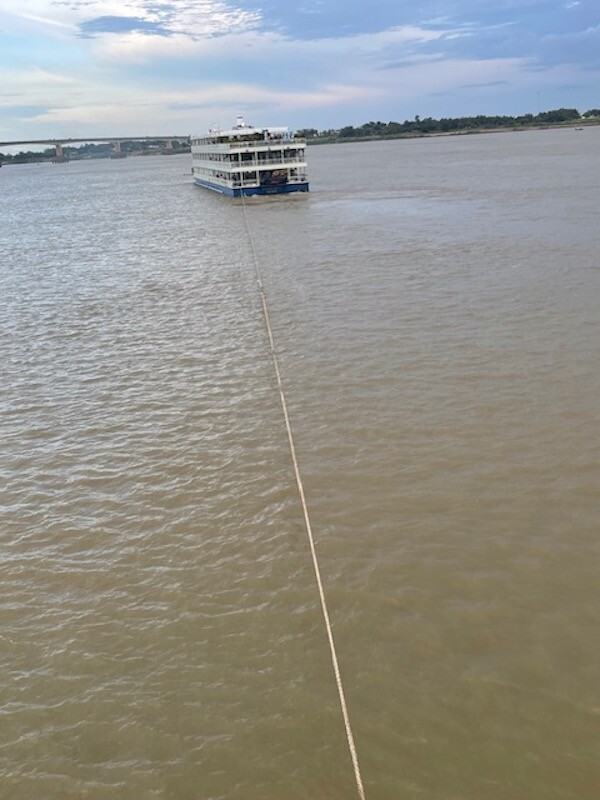In last week’s blog, I wrote about my Vietnam and Cambodia river cruise vessel, the AmaDara, that grounded in a sand bank at our final stopping point and the efforts to get it unstuck. Now I can tell you about additional efforts that cruise vessel personnel used to try and get us off the sand bank.
We went to bed with no knowledge of what Plan D would be for getting our river cruise vessel AmaDara unstuck. Ship and cruise officials assured us they were working on multiple options. Since they didn’t know that night which one the company would try, they told us we would find out in the morning.
At 2 a.m., we awoke to the roar of diesel engines. Thinking it was our ship trying to back out from the sand bar, we got up to look. We were greeted with spotlights and two river mining ships trying to pump sand and water away from our ship’s hull. These miners were lined up directly with our cabin. For nearly two-and-a-half hours we were serenaded with the sound of diesel engines pumping away. Goodbye to any thoughts of sleep.
When the noise stopped, we concluded Plan D must have worked and our ship had been freed. At daybreak, we discovered that no, we were still stuck. So, what was the next plan?
Going on deck brought the revelation that a ferry boat was present. Of course, load us on to the ferry and deliver us to the real docking station. As the 100-plus pieces of luggage were loaded on to the ferry, the question was if the luggage was heading to the dock or just to the riverbank. The answer was the riverbank. The ship’s crew carried all the luggage up the steep 75-foot embankment. Oh boy, we were going to have to make that same climb to reach our buses.
The climb proved less challenging with the aid of crewmembers who helped passengers who were less mobile. Once loaded on to the buses, we were off to Siem Reap, a five-hour trip. We were told that the river miners not only pumped away water and sand but had also emptied the ship’s hull of any accumulated water and sand, helping to lighten the ship. We were also told that a tug was being summoned to help.
The next morning, we were told the ship had been freed the previous evening. We also learned that the two river mining boats began pumping sand away and five tugs arrived to pull the AmaDara from its parked position.
I didn’t see any tugs on the river journey since Phnom Penh, so I guessed that the tugs needed to make the long journey from Phnom Penh and Kampong Chem which is about 125 kilometers (78 miles). Since no vessels that I saw were going very fast on the Mekong River, partly because of the current, I estimated that the tug might travel at a top speed of 10 miles per hour for a roughly eight-hour journey. Not one but five tugs were needed to free our ship. It’s better to have too much rather than too little pulling power.
Dollar signs spin in my head when I think about what the cost was to free the AmaDara. Essentially, a full day’s time and the cost of the fuel up and back to Phnom Penh for the five tugs would make up much of the bill. Then there was the charter expense for the two river mining vessels. This cruise trip may have cost the cruise operator, AmaWaterways, a lot of money.
It will be interesting to see if we hear anything from the company, or whether the mishap disappears into a memory black hole. I must believe that the first mate, who was at the wheel when the AmaDara went aground, lost his job. Did this incident end his career?




